Baseball Position Behind The Batter
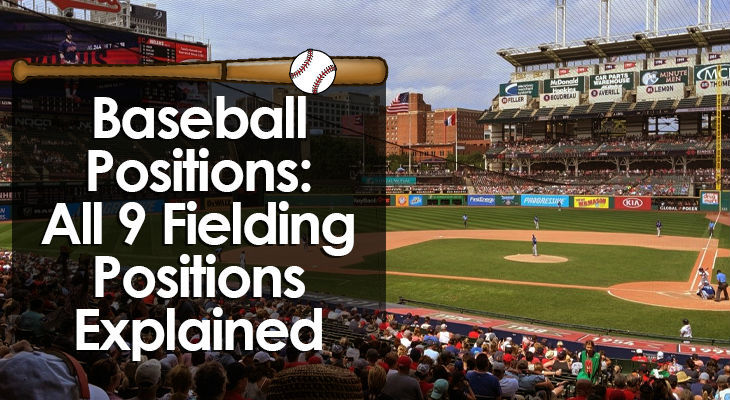
Baseball Positions: All 9 Fielding Positions Explained
Let's start off super simple...
In baseball, like most sports, there is a defense and an offense. The defensive players are known as 'fielders'.
There are 9 fielding positions in baseball.
For the purposes of getting to know the dissimilar baseball positions, let's go in numerical order based on the scorebook.
The positions in baseball are as follows:
ane. Pitcher
ii. Catcher
3. First Baseman
four. 2d Baseman
v. Third baseman
6. Shortstop
7. Left Fielder
eight. Center Fielder
nine. Right Fielder
Let's discuss each fielding position in more depth…
The ix Baseball Positions Explained
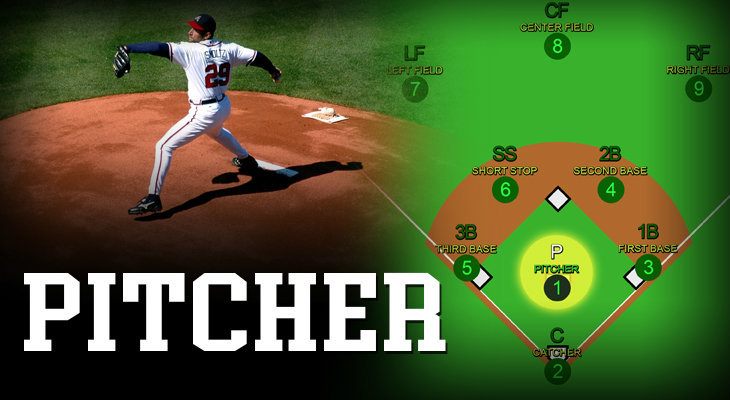
1. Pitcher
(Notable Pitchers: Clayton Kershaw, Justin Verlander, Nolan Ryan, Corey Kluber, and Aroldis Chapman.) The pitcher is the defensive player that starts every individual play. They are positioned on the pitching mound and must be touching the rubber to deliver a pitch. The pitch will be thrown to the catcher who is positioned behind habitation plate. The objective of the bullpen is to get batters out; either by a struck ball or strikeout, where the hitter records three strikes in an at-bat. To be an constructive pitcher, the role player must be able to throw accurately to diverse targets in the strike zone. The most elite pitchers are able to combine pitch location with varying speeds, ball movement, and power to strategically sequence pitches to deceive the hitter. It is a bonus to have a pitcher who is quick and athletic to field their position, just many of the best pitchers in the history of the game were not the almost agile. Pitchers tin be either right or left handed, with a preference for left-handed pitching. "Why a preference for left-handers?" Left handers are more unique, giving hitters a different perception of pitches and usually different movement of pitches. Left-handers as well are statistically favored the most when trying to retire left-handed hitters due to the rarity of the matchup and the path of the baseball game working from at the hitter to across the plate. When a batter does attain base of operations, a pitcher must be able to concord the runner on. They practice this by being able to vary timings of their delivery of the pitch to abode plate and as well the ability to perform a quick pickoff motion to proceed runners from leading off too far from bases. Quick anxiety and quick release of the throw aides in constructive prevention of stolen bases. Worth noting is the left-handed pitcher's considerable advantage at holding runners on first base of operations due to them facing the base and likewise the pickoff movement they are able to perform which is much more deceptive to a runner. There are also varying roles for pitchers... ane. Starting Pitcher Starters begin the game as the pitcher and are usually asked to pitch for many innings at a fourth dimension. They tend to be more than command specialists with many different pitches to throw. Later on the starter is tired or has been proven ineffective by yielding besides many runs, hits, or walks, a relief pitcher is used. 2. Relief Pitcher Relief pitchers come in during the middle of the game. Relief roles too vary from long relief (a pitcher coming in to pitch lots of innings in one game), middle relief (usually the late innings, just non required to finish a game) and closer (the pitcher who will endeavour to tape the last outs of a game). Relief pitchers generally are harder throwers that rely on only a couple of pitches to retire batters; although there are many exceptions to that generality. They as well tend to have less stamina and may exist asked to pitch in back to dorsum games. Ultimately, the pitcher'south number i job is to get opposition players out without giving up runs.
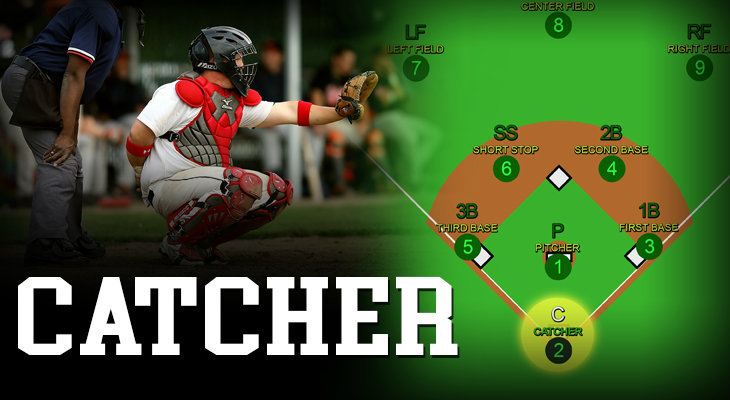
2. Catcher
(Notable Catchers: Buster Posey, Yadier Molina, Salvador Perez, and Ivan Rodriguez.)
The catcher is known as the field general of the defence equally they are the only thespian facing outward toward the entire playing field.
He is positioned backside home plate and the batter to receive pitches from the pitcher.
The all-time catchers are a omnibus on the field every bit they are experts in defensive positioning, calling pitches, and also communicating.
They volition sometimes go talk to the pitcher to at-home their nerves, requite words of encouragement, or sometimes propose the pitcher to make an adjustment.
Catchers put down signs that are hidden from the offense to betoken to the bullpen which pitch to throw each play, usually indicating location equally well.
Sometimes the catcher volition call his ain pitches, while at many levels of baseball the autobus volition call the pitch from the dugout and so the signal is relayed to the pitcher.
Due to the nature of the position, the catcher must have quick feet, quick easily, and also exist extremely tough.
When pitches are thrown in the clay, the catcher is required to block the ball by using their body every bit a shield to prevent the ball from getting past him. If a brawl gets past the catcher, it is almost sure to issue in a runner advancing to a base.
The quickness of feet and hands is also of import in the case of managing baserunners. In social club to throw out a stealing runner, catchers must be able to receive the pitch and release the baseball game uncommonly apace.
A potent arm on a catcher is very preferable. If a catcher is able to deliver a throw with higher velocity, that makes up for a slower commutation or footwork.
Catchers are more often than not shorter in stature and right-handed. Correct-handed catchers are able to deliver a better throw to third base in case of a steal. In fact, left-handed catchers are nearly unheard of in professional baseball.
Catchers vary in hitting power but are usually more valuable to a team for their defence. Those who can also striking well provide a luxury to a team and are a very hot commodity.
Also worth noting is that the catcher has i of the game's umpires positioned direct behind him for the entire game. So not only does the catcher need to be tough, smart, and athletic, but as well must exist a diplomatic representative of the team to the officials.
Having the proper demeanour may lend itself at times to the do good of the dubiety on pitches that will favor that player'due south team, although a adept official won't allow that to factor in.
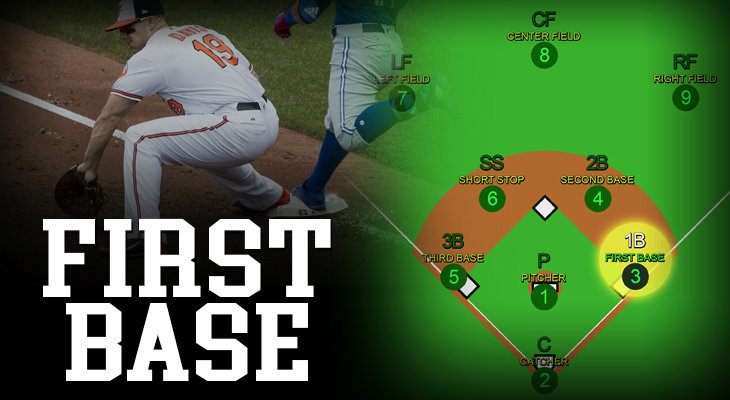
3. Offset Baseman
(Notable Offset Basemen: Miguel Cabrera, Joey Votto, Lou Gehrig, and Paul Goldschmidt)
The first baseman is the most involved defensive player in the game in regards to playing action other than the pitcher and catcher.
The showtime baseman is positioned closest to commencement base, ordinarily playing a few feet behind the baseline and into off-white territory from the starting time baseline.
Starting time baseman can be either left handed or right handed, but there is a preference toward a left-handed first baseman defensively...
Left-handers have their glove on the right hand, allowing for better positioning for tags on pickoff plays, and also have their throwing arm on the side of their torso that allows them to throw to second base of operations on a potential double-play situation without rotating their trunk.
Due to the first baseman's chief role being a receiver of throws, the fielder needs to be very skillful at catching the ball and also scooping up balls that hitting the clay earlier arriving near first base.
First basemen are usually one of the all-time hitters on their team and usually hitting for power (home runs, doubles).
It is always favorable to accept an athletic thespian at first, merely traditionally the corner infielders (1st and 3rd baseman) are larger guys that hit for power as mobility isn't as necessary to play those positions.
Commencement basemen usually are not known for their throwing arm strength and it is non every bit much of a necessity at first due to the nature of the position.
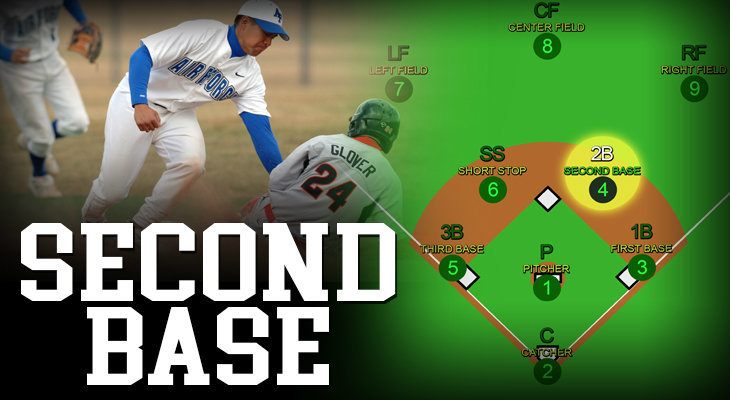
4. Second Baseman
(Notable 2d Basemen: Jackie Robinson, Jose Altuvé, Ian Kinsler, and Craig Biggio)
Second basemen are known as middle infielders.
They position themselves between the beginning and second bases, shading toward second base to encompass the middle of the infield.
Eye infielders need to be quick and agile, often having to become rid of the ball rapidly and comprehend lots of footing. (They are heavily involved in double plays as well, where a runner is retired at second and offset base in the same play.)
It is preferred for a second baseman to be correct-handed. Like catchers, left-handers every bit second baseman are unheard of in professional person baseball.
This generally has to practice with the throwing arm beingness away from the main throwing target, which allows for a quicker release of the brawl to outset base without the fielder having to pivot or plow to make a play to first.
Due to their positioning, 2nd baseman have a shorter throw to first and usually more time to make a play, so they are traditionally a fiddling less agile and have a little less arm force than the shortstop.
That being said, they notwithstanding assistance anchor the centre of the infield and are vital to an effective defense.

5. Third Baseman
(Notable Third Basemen: Brooks Robinson, Chipper Jones, Kris Bryant, Josh Donaldson, and Manny Machado)
Third base is also known as the "hot corner". The nickname comes from the fact that 3rd base requires the fastest reaction time on the field.
Third basemen are very versatile in skill set. They must have a strong arm due to the length of the throw to first base of operations and they must be very quick to handle a hard hit ball past a correct-hander downwards the third baseline or a bunt by a batter.
They do not need to be quite a mobile as a middle infielder, but it is never a bad affair.
Third baseman are usually bigger in stature and ordinarily a prime position for another one of your ability hitters. Along with 1st base, this corner infielder position is usually where you put some of your to the lowest degree mobile players with great aptitude for hitting.
Right-handed players are oftentimes the rule for this position; just like the shortstop, second base of operations, and catcher positions.
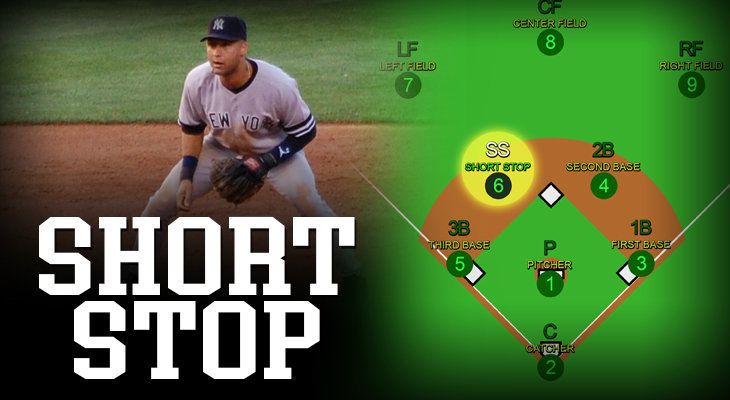
6. Shortstop
(Notable Shortstops: Ozzie Smith, Derek Jeter, Carlos Correa, and Francisco Lindor)
Shortstops are the anchor of the infield defense and are the other center infield position. They play betwixt the second and tertiary bases, shaded heavily toward second base.
Their role is to comprehend balls striking from the second base moving to the batter's left until the third baseman.
Shortstops at high levels of baseball game are exclusively right-handed, once more to allow for quick substitution from fielding to throwing without whatever other movement needed.
Shortstops must have strong arms to make throws from a long distance to showtime base. They have the most ground to cover and must be extremely agile to get up later on a diving terminate to retire a runner.
They are heavily involved in double plays (like the 2nd baseman) and often times are the fielder in charge of putting out base stealers at second base.
They are the main communicator to the outfield in strategic situations with different hitters and too communicate and set up upward the defense in bunt situations.
In cases where a ball is hit to the outfield, the shortstop besides serves as a relay to redirect throws and also complete plays at 2nd, 3rd, or home. Shortstops also have priority on fly balls on the infield when multiple fielders converge.
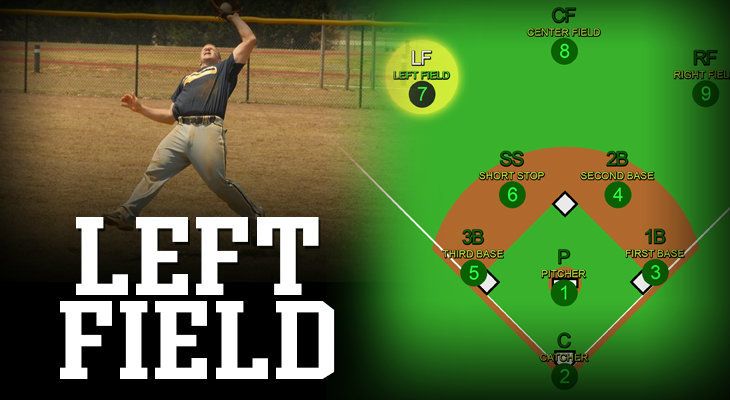
7. Left Fielder
(Notable Left Fielders: Ted Williams, Barry Bonds, Marcell Ozuna, and Justin Upton)
Left field is 1 of the 3 outfield positions, meaning they play the positions the farthest abroad from abode plate. It is a corner outfield position, which means they have less territory to cover.
Left fielders traditionally accept the weakest arms in the outfield since they have the shortest throw to third base of any outfield positions.
Although they do have more assurance hitting their manner statistically than right fielders due to the prevalence of right-handed hitters overall in baseball game.
Outfielders can exist either dexterity with no penalty. Left field and right field are also peachy places to put your power hitters with a picayune less mobility.

8. Center Fielder
(Notable Center Fielders: Willie Mays, Mike Trout, and Andrew McCutcheon)
Centerfielders are one of the most important baseball positions on the defense force.
They accept to cover the greatest area of any player on defense, requiring them to be one of the fastest players on the squad.
It'south incredibly important that they get neat reads on hitting balls and they must be able to read hitters to shift slightly to have a better jump on any hitting ball.
They are the helm of the outfield and have catching priority over any other outfielder when multiple players converge.
They will too call off any infielder catching a ball if they tin, because of their motion existence in toward the ball instead of having to backpedal or grab over the shoulder.
Centre fielders need to take potent artillery to assist in throwing out runners on the bases on extra base hits too. They can be either left or right handed with no clear reward to either dexterity.
Ofttimes times, due to their athleticism and speed, centerfielders are plant every bit leadoff hitters in your lineup and base of operations stealing threats.
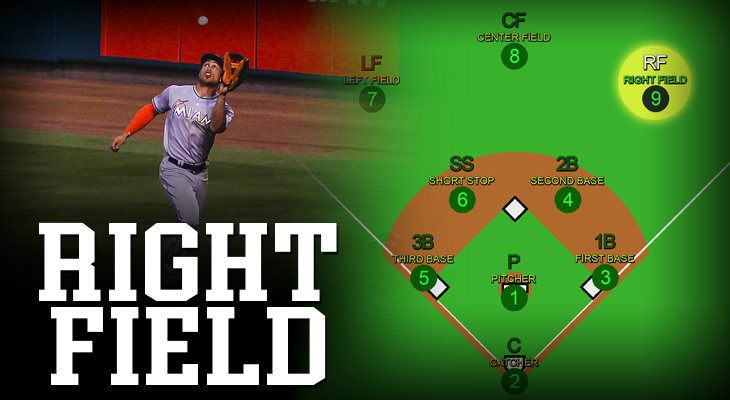
9. Right Fielder
(Notable Correct Fielders: Infant Ruth, Hank Aaron, Aaron Judge, Giancarlo Stanton, and Bryce Harper)
Right field is the dwelling house to some of the most iconic baseball game hitters of all time and is another corner outfield position.
They usually possess the strongest arm in the outfield due to having the longest throw to third base for an outfielder. Like all other outfielders, dexterity of a player is not a cistron.
They see the to the lowest degree amount of balls of any of the outfielders but are still required to cover lots of ground. They are most likely to be the fielder that tin forestall potential triples that are hit in the right centerfield gap or down the right field line.
Offensively, right field is where your power hitters tin can exist stationed if you already have first base and 3rd base filled on the infield.
Conclusion:
Each of the nine baseball positions on defense requires different strengths and also lends itself to a certain blazon of offensive player.
As we've discussed, a player's dexterity may as well matter depending on the position.
With the traditional roles defined, nosotros may see more and more shifts due to player tendencies. For example, a shortstop may play the left side of the infield by himself, or accept a second baseman play in the right-field grass.
In the case of histrion development, the more positions a role player knows, the greater the chance the jitney will be able to get them in the lineup each game.
Baseball Position Behind The Batter,
Source: https://baseballcoachinglab.com/baseball-positions/
Posted by: sheltonposeveropme.blogspot.com


0 Response to "Baseball Position Behind The Batter"
Post a Comment